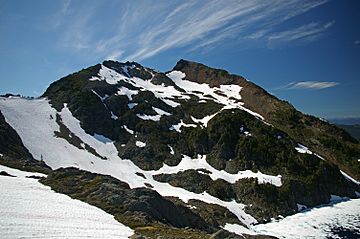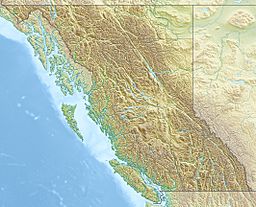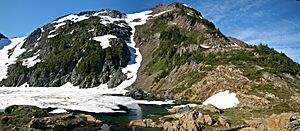Mount MacFarlane facts for kids
Quick facts for kids Mount MacFarlane |
|
|---|---|

Mt. MacFarlane, east aspect
|
|
| Highest point | |
| Elevation | 2,090 m (6,860 ft) |
| Prominence | 140 m (460 ft) |
| Parent peak | Crossover Peak |
| Geography | |
| Location | British Columbia, Canada |
| Parent range | Skagit Range North Cascades |
| Topo map | NTS 92H/4 |
| Geology | |
| Mountain type | Intrusive |
| Volcanic arc/belt | Pemberton Volcanic Belt |
| Climbing | |
| Easiest route | Scrambling via northeast ridge |
Mount MacFarlane is a tall mountain in the Cascade Mountains of southwestern British Columbia, Canada. It stands about 2,090 meters (6,857 feet) high.
It's located about 6 kilometers (3.7 miles) north of the border between Canada and the United States. Nearby peaks include Slesse Mountain and Crossover Peak. Water from rain and snow on the mountain flows into Slesse Creek and Pierce Creek. These creeks eventually join the Chilliwack River.
The mountain is named after Ronald E. MacFarlane. He was a young First Lieutenant in the Royal Canadian Air Force from nearby Chilliwack. He sadly passed away in action on December 16, 1943, when he was just 21 years old. The name was officially chosen on April 7, 1955.
Contents
How Mount MacFarlane Formed
Mount MacFarlane is part of a large rock formation called the Chilliwack batholith. This formation pushed its way into the Earth's crust about 26 to 29 million years ago. This happened after major mountain-building events in the area.
The mountain is also part of the Pemberton Volcanic Belt. This was once a chain of volcanoes that formed when one of Earth's plates, the Farallon Plate, slid under another plate. This process, called subduction, started about 29 million years ago. Over time, these volcanoes have worn away.
Ice Age Impact on the Landscape
During the Pleistocene period, which began over two million years ago, huge sheets of ice called glaciers covered the land. These glaciers moved forward and then melted back many times. As they moved, they scraped and shaped the landscape.
This process left behind piles of rock and debris. The "U"-shaped valleys you see in the area were carved out by these powerful glaciers. The combination of land rising up (uplift) and cracks in the Earth's crust (faulting), along with glaciation, created the tall peaks and deep valleys of the North Cascades.
The North Cascades region has some of the most rugged land in the Cascade Range. You can see jagged peaks, sharp ridges, deep valleys carved by glaciers, and tall, pointed rock formations made of granite. These geological events created the varied landscape and big changes in elevation. This also led to different climates and types of plants in the area.
Weather and Climate at Mount MacFarlane
Mount MacFarlane is located in a marine west coast climate zone. This means it gets a lot of rain and snow. Most weather systems come from the Pacific Ocean and move east.
When these weather systems reach the Cascade Range, the mountains force the air upward. This process is called Orographic lift. As the air rises, it cools and drops its moisture as rain or snowfall. Because of this, the Cascade Mountains get a lot of precipitation, especially snow in winter.
Temperatures and Best Time to Visit
Winter temperatures on Mount MacFarlane can drop very low. They can go below -20 °C (-4 °F), and with the wind, it can feel even colder, below -30 °C (-22 °F).
If you want to climb Mount MacFarlane, the best time to visit is usually from July through September. The weather is most favorable during these months.
Climbing Mount MacFarlane
There are known ways to climb Mount MacFarlane.
- Northeast Ridge - This route is rated as class 3. You can reach it by following the Pierce Lake Trail.




